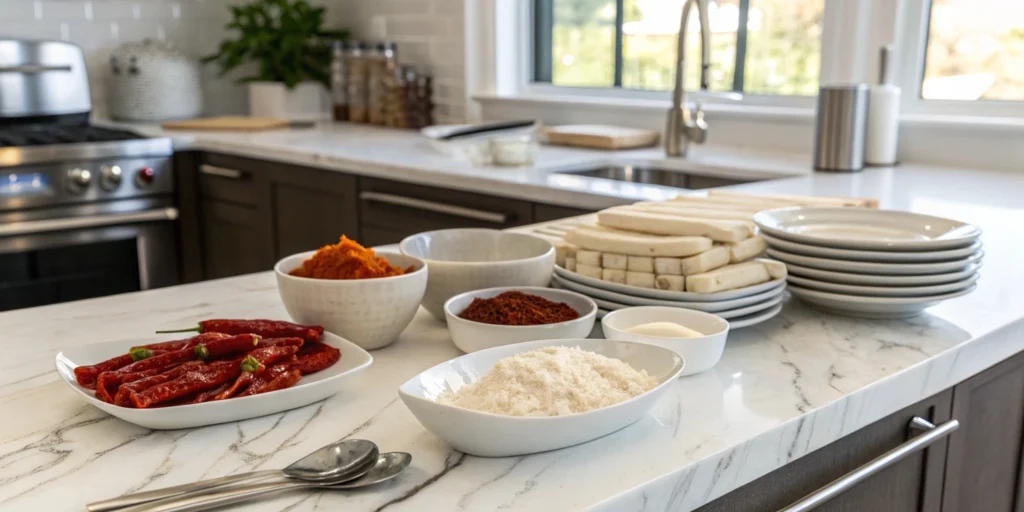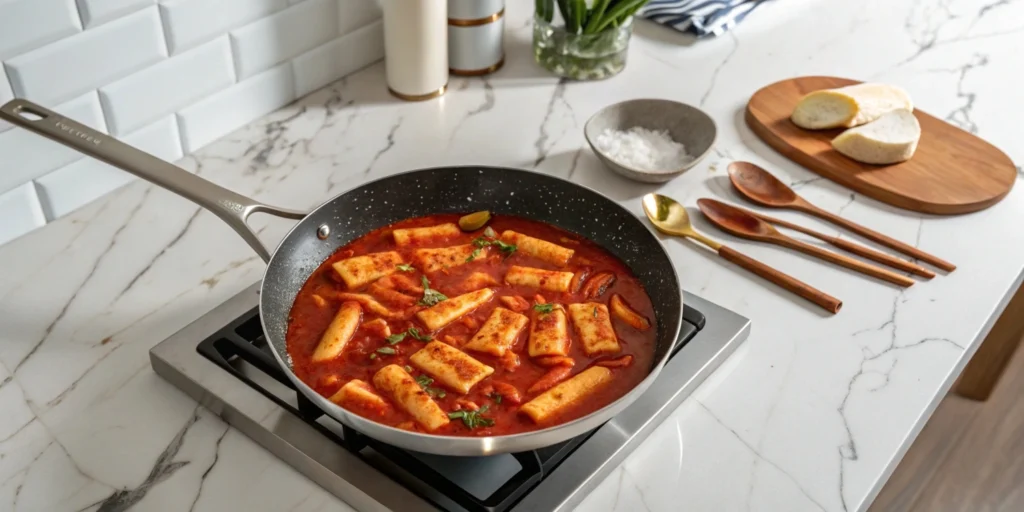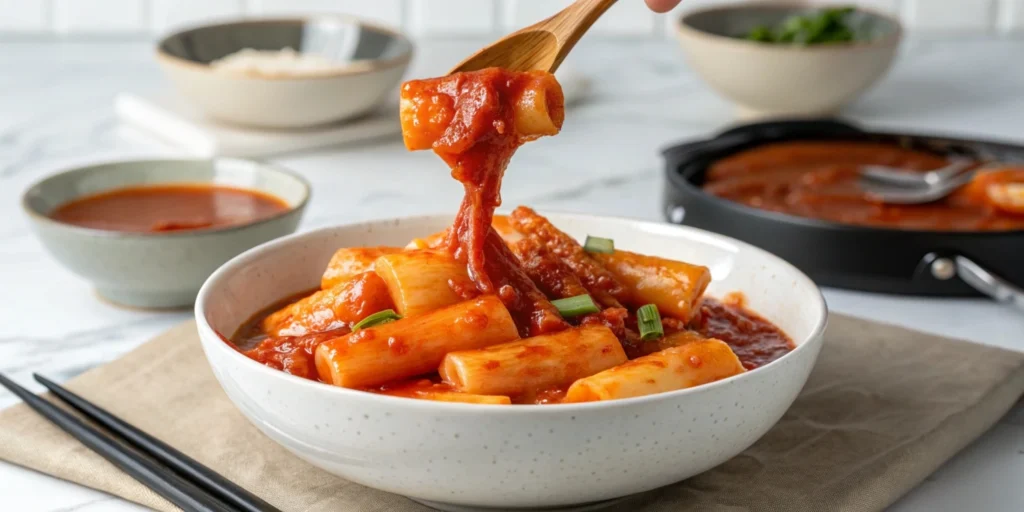
Table of Contents
Tteokbokki is a dish that captures the essence of Korean comfort food, balancing sweet, spicy, and savory elements to perfection. Whether you’re enjoying it from a street vendor in Seoul or preparing it at home, the warm, chewy rice cakes coated in rich, spicy sauce are guaranteed to bring a smile to your face. However, like most beloved dishes, there are a few secrets to achieving authentic flavor that separates the good from the extraordinary. In this article, we’ll take a deep dive into the secrets of crafting a perfect tteokbokki with tips that will transform your cooking experience and elevate the taste to the next level.
What is Tteokbokki? A Snapshot of Korea’s Most Beloved Street Food
Tteokbokki (떡볶이) is a staple of Korean street food culture, known for its sweet, spicy, and savory flavors. The dish consists primarily of chewy rice cakes (tteok) immersed in a sauce made from gochujang (Korean chili paste), soy sauce, sugar, garlic, and other seasonings. It’s a dish that speaks to Korea’s history, and it has evolved over time from being a royal court dish to a popular snack found at street stalls and restaurants all over the country.
Why Tteokbokki Is So Special:
Tteokbokki is more than just food; it’s a part of Korean culture. It’s served at street food carts, in restaurants, and even at home, with countless variations to suit different tastes. Whether you’re enjoying a mild, family-friendly version or a fiery, spice-laden one, there’s no wrong way to enjoy tteokbokki.
5 Secret Tricks for Crafting Authentic Tteokbokki
1. The Sauce is Everything: How to Achieve the Perfect Balance of Sweet and Spicy
The sauce is the soul of tteokbokki, and getting it just right is crucial for authentic flavor. This rich, glossy sauce needs to balance heat, sweetness, and umami, and there are a few tricks to perfecting it.

- Gochujang (Korean Chili Paste): The heart of the sauce, gochujang provides both spice and a unique fermented flavor that defines tteokbokki. Make sure to use a high-quality gochujang, as cheap versions may lack the depth of flavor.
- Gochugaru (Korean Red Pepper Flakes): Adding a sprinkle of gochugaru helps intensify the heat and gives the dish a beautiful red hue. For authentic flavor, choose a medium-fine ground version of gochujang for a balanced spice.
- Soy Sauce and Sugar: These ingredients bring a savory depth and sweetness to the sauce, rounding out the heat. Be careful with the sugar—too much can overpower the dish, so aim for just enough to balance the heat of the gochujang.
Tip: For the ultimate flavor, use a ratio of 2 tablespoons of gochujang to 1 tablespoon of soy sauce, and add about 1 tablespoon of sugar for balance. You can adjust this to taste, but don’t skimp on the gochujang—it’s the key to the perfect tteokbokki.
2. Achieving the Perfect Texture for Rice Cakes: Chewy, Not Mushy
The rice cakes, or “tteok,” are the foundation of this dish. Whether you’re using fresh or frozen tteok, their texture will make or break the dish.
- Soaking Frozen Rice Cakes: If you’re using frozen rice cakes, make sure to soak them in warm water for at least 30 minutes before cooking. This helps to soften them and prevents them from becoming too hard when cooked.
- Cooking Technique: Once the rice cakes are softened, cook them in the sauce over medium heat. Let them simmer gently until they absorb the flavors of the sauce. This method ensures that they stay chewy without becoming mushy. You want them tender but firm enough to bite into.

Tip: For the best texture, cook your rice cakes in the sauce for around 10–15 minutes, depending on how chewy you prefer them.
3. Adding Layers of Flavor with Fish Cakes (Eomuk) and Toppings
While the rice cakes and sauce are the main components, adding fish cakes (eomuk) or other toppings can elevate the dish and add layers of texture and flavor.
- Fish Cakes (Eomuk): Fish cakes are a classic addition to tteokbokki, adding a savory depth that balances the sweet-spicy sauce. When choosing eomuk, look for fresh or frozen fish cakes that are sliced thinly. These will absorb the sauce well and add a delightful texture.
- Optional Toppings: For additional flavor complexity, top your tteokbokki with boiled eggs, sliced scallions, kimchi, or sesame seeds. These not only improve the taste but also add visual appeal to the dish.
Tip: If you prefer a vegetarian version, swap out the fish cakes for tofu or mushrooms. Both ingredients soak up the sauce beautifully and complement the flavors of the dish.
4. The Right Heat Level: Adjusting Spice to Your Preference
One of the hallmarks of tteokbokki is its spice, but not everyone enjoys the same level of heat. You can easily adjust the spice to suit your personal taste.
- Controlling Spice: The heat in tteokbokki comes primarily from the gochujang and gochugaru. If you prefer a milder version, start with less gochujang and opt for a mild or sweet variety of gochugaru. For those who love heat, you can increase the amount of both, or even add fresh chili peppers to the mix.
- Balancing Spice with Sweetness: If the dish becomes too spicy, you can balance it by adding a bit more sugar or honey. This will help mellow the heat and bring the flavors into harmony.
Tip: Start with a small amount of gochujang and add more as you go. It’s easier to increase the spice level than to tone it down.
5. The Power of Patience: Let It Rest for Maximum Flavor
After you’ve finished cooking your tteokbokki, allow it to rest for a few minutes before serving. This simple step can make a huge difference in the flavor.
- Why Resting Matters: Allowing the dish to rest gives the rice cakes more time to absorb the sauce, resulting in a more flavorful bite. The sauce also thickens slightly, making it cling to the rice cakes more effectively.
- Optimal Rest Time: Let the dish rest for 5–10 minutes. This will ensure that the rice cakes are perfectly infused with the sweet, spicy sauce.

Tip: If you’re serving tteokbokki to guests, make it a few minutes ahead of time and let it sit while you finish preparing the rest of your meal. This will give you the best flavor and texture.
A Personal Memory: My First Encounter with Tteokbokki in Seoul
When I first arrived in Seoul in 2018, I was both excited and overwhelmed by the vibrant food scene. On one particularly cold afternoon, I found myself standing in front of a street vendor, drawn by the irresistible aroma of sizzling tteokbokki. I decided to try it, but as soon as I took that first bite, I was hit with an intense wave of spice that brought tears to my eyes. The heat from the gochujang was unlike anything I had ever experienced, and I quickly reached for a drink to cool my burning mouth.
However, what struck me more than the spice was the sheer deliciousness of the dish. The chewy rice cakes soaked in that fiery, sweet sauce were simply exquisite. Despite the spice, there was a comforting balance of flavors that made me want more. And the best part? It was inexpensive—one of the most satisfying meals I’d had for just a few thousand won. That moment, when the heat of the dish brought me to tears, has stayed with me ever since, and it sparked my deep love for this iconic Korean street food.
Tteokbokki Variations – Customize Your Dish
Tteokbokki is a versatile dish that can be easily customized to suit your tastes or dietary preferences. Here are some variations to consider:
- Vegan Tteokbokki: Replace the fish cakes with tofu, mushrooms, or even tempeh for a vegan-friendly version.
- Extra Spicy Tteokbokki: If you’re a spice lover, add more gochugaru, fresh chili peppers, or even a dash of gochujang’s spicier variant for an extra fiery kick.
- Sweet Tteokbokki: For a sweeter twist, you can add a bit more sugar or honey to the sauce, creating a unique fusion of flavors that will surprise your taste buds.
- Cheese Tteokbokki: One of the newer trends in tteokbokki variations is adding melted cheese on top. The rich, creamy texture of cheese contrasts perfectly with the spicy, sweet rice cakes.

Tip: Experiment with adding vegetables like cabbage, zucchini, or carrots for extra crunch and flavor.
Frequently Asked Questions (FAQs)
Q1: Can I make tteokbokki in advance?
Yes, tteokbokki can be made ahead of time and stored in the refrigerator for up to 2 days. When reheating, add a little water to the sauce to prevent it from becoming too thick.
Q2: What if I don’t have gochujang?
Gochujang is essential for authentic flavor, but if you don’t have it, you can substitute with another chili paste or hot sauce. However, the flavor will be different, and you won’t achieve the same depth.
Q3: Can I use rice noodles instead of rice cakes?
While rice noodles won’t give you the chewy texture of rice cakes, they can be a suitable substitute for a different texture and are great if you’re looking for something lighter.
With these secrets in your culinary arsenal, you’re ready to master tteokbokki at home! Whether you’re drawn to its sweet-spicy allure or the comforting texture of the rice cakes, this dish will undoubtedly become a favorite in your kitchen. Try it for yourself and experience the taste of Korea in every bite!
